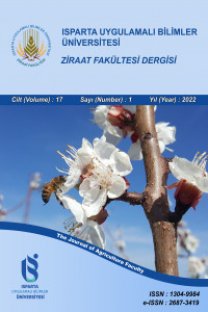Yield and mineral nutrition content of buckwheat (Fagopyrum esculentum Moench): The effect of harvest times
Karabuğday (Fagopyrum esculentum Moench)’ın verim ve mineral besin çeriği: Hasat zamanının etkisi
___
Açıkgöz, E. 2001. Forage Crops (3rd press). Uludag University Puplication No:182, Bursa, 584p.Alkhatib, K. and Paulsen, G.M. 1990. Photosynthesis and productivity during high-temperature stress of wheat genotypes from major world regions. Crop Science, 1990, 30:1127- 1132.
Barta, J., Kalinova, J., Moudry, J. and Curn, V. 2004. Effects of environmental factors on protein content and composition in buckwheat flour. Cereal Research Communication, 2004, 32:541-548.
Bloom, A.J., Burger, M., Asensio J.S.R. and Cousins, A.B. 2010. Carbon dioxide enrichment inhibits nitrate assimilation in wheat and arabidopsis. Science, 2010, 328:899-903.
Campbell, C.G. 1983. Manor buckwheat. Canadian Journal of Plant Science, 1983, 63:1053-1054.
Campbell, C.G. 1997. Buckwheat (Fagopyrum esculentum Moench.) promoting the conservation and use of underutilized and neglected crops. 19. Institute of Plant Genetics and Crop Plant Research, Gatersleben/International Plant Genetic Resources Institute, Rome, Italy.
Christensen, K.B., Kaemper, M., Loges, R., Frette, X.C., Christensen L.P. and Grevsen, K. 2010. Effects of nitrogen fertilization, harvest time, and species on the concentration of polyphenols in aerial parts and seeds of normal and tartary buckwheat (Fagopyrum sp.). European Journal of HortiScience, 2010, 75(4):153–164.
Christa, K. and Soral-Smietana, M. 2008. Buckwheat grains and buckwheat products-nutritional and prophylactic value of their components-a review. Czech J. of Food Sci., 2008, 26:153– 162.
Dear, B., Kaiser, A. and Pilt, J. 2005. Yield and Digestibility of Legume and Oat Forages. Profitable & Sustainable Primary Industries, 52, 2005.
Dias, A.S., Lidon, F.C. and Ramalho, J.C. 2009. Heat stress in Triticum: kinetics of Fe and Mn accumulation. Brazilian Journal of Plant Philology, 2009, 21:153-164.
Dizlek, D., Özer, M.S., nanç, E. and Gül, H. 2009. Composition of buckwheat (Fagopyrum esculentum Moench) and its possible uses in food industry. Gıda,2009, 34(5):317-324.
Girma, K., Holtz, S., Tuban, B., Solie, J. and Raun, W. 2011. Nitrogen accumulation in shoots as a function of growth stage of corn and winter wheat. Journal of Plant Nutrition, 2011, 34:165-182.
Ikeda, S. and Yamashita, Y. 1994. Buckwheat as a dietary source of zinc, copper and manganese. Fagopyrum, 1994, 14:29-34.
Ikeda, S., Yamashita, Y. and Murakami, T. 1995. Minerals in buckwheat. Current Advances in Buckwheat Research: 789792 (Proc, 6th IntI. Syrup. Buckwheat at Ina)
Ikeda, S., Yamashita, Y. and Kreft, I. 1999. Mineral composition of buckwheat by-products and its processing characteristics to konjak preparation. Fagopyrum, 1999, 16:89-94.
Kara, B., Atar, B. and Gül, H. 2012. Effects of different sowing dates on protein, sugar and dry matter of sweet corn. Research on Crops, 2012, 13(2):493- 497.
Kilcher, M.R. and Troelsen, J.E. 1973. Contribution and nutritive value of the major plant components of oats through progressive stages of development. Canadian Journal of Plant Science, 1973, 53:251-256.
Korkmaz, A., Gülser, C., Manga, . and Sancak, C. 1993. Effects of planting systems and cutting time on mineral content and quality of forage plants from Samsun district. Turkish Journal of Agriculture and Forestry, 1993, 17:1069-1080.
Kozak, U.K., Wronkowska, M. and Smietana, M.S. 2011. Effect of buckwheat flour on microelements and proteins contents in gluten-free bread. Czech Journal of Food Science, 2011, 29(2):103-108.
Martin, P.J.Z., Garcia, B.I. and Rivilla, M. 1989. Nutritive value of winter cereals used for forage in the west central zone of Spain. Herbage Abstract, 1989, 522, 3923.
Nashriyah, M., Shamsiah, A.R., Salmah, M., Misman, S., Maizatul, M., Akmam, N., Jamaliah, M.Y. and Mazleha, M. 2010. Growth and mineral content of Mokara charkkuan Pink Orchid as affected by allelopathic Lantana camara weed. International Journal of Agriculture and Biology Science, 2010, 1(1):35-39.
Russelle, M.P., Wilhelm, W.W., Olson, R.A. and Power, J.F. 2004. Growth analysis based on degree days, http://digitalcommons.unl.edu/usdaars facpub/123. (Accessed September 12, 2013)
Smith, D. 1976. Yield and chemical composition of oats for forage with advance in maturity. Agronomy Journal, 1976, 68:637-638.
Stibilj, V., Kreft, I., Smrkolj, P. and Osvald, J. 2004. Enhanced selenium content in buckwheat (Fagopyrum esculentum Moench) and pumpkin (Cucurbita pepo L.) seeds by foliar fertilization. European Food Research and Technology, 2004, 219:142–144.
Tahir, I. and Farooq, S. 1988. Review article on buckwheat. Fagopyrum, 1988, 8:33-53.
Tsuneo, N. 2004. A history of buckwheat (soba noodle seed) and its advantages. Foods and Food Ingreded Journal, 2004, 209 (4):345-353.
TÜİK., 2012. Turkey Statistical Institute, www.tuik.gov.tr
Vojtiskova, P., Kmentova, K., Kuban, V. and Kracmar, S. 2012. Chemical composıtıon of buckwheat plant (Fagopyrum esculentum) and selected buckwheat products. Journal of Microbiology Biotechnology and Food Science, 2012, 1:1011-1019.
Ye, N. and Guo, G. 1992. Classification, origin and evolution of genus Fagopyrum in China. Proc. 5th Int’l Symp. On Buckwheat. 20-26 Aug. 1992. pp. 19-28, Taiyuan, China.
Wijngaard, H.H. and Arendt, E.K. 2006. Buckwheat. Cereal Chemistry, 2006, 83(4):391-401.
Zhou, J. 2003. Traditional Chinese medicines: Molecular structures, natural sources and applications/compiled by Zhou, J., G. Xie and X. Yan; In: Milne, G.W.A. (ed.): 2nd ed. Ashgate Publishing Ltd, Hampshire, England.
- ISSN: 1304-9984
- Yayın Aralığı: Yılda 2 Sayı
- Başlangıç: 2006
- Yayıncı: Isparta Uygulamalı Bilimler Üniversitesi
Ulukan BÜYÜKARIKAN, Mevlüt GÜL
Çukurova Bölgesinde Kükürt Kaynak ve Dozlarının Pamuk Verimine Etkisi
Bazı Tritikale Genotiplerinin Batı Geçit Bölgesinde Verim ve Verim Unsurlarının Belirlenmesi
Karabuğday (Fagopyrum esculentum Moench)’ın Verim ve Mineral Besin İçeriği: Hasat Zamanının Etkisi
Telli Terbiye Sisteminin Lobesia botrana Den.&Schiff. (Lepidoptera: Tortricidae) Üzerine Etkisi
Ali Kemal BİRGÜCÜ, Ferit TURANLI, Ebru GÜMÜŞ, Beril GÜZEL, Yusuf KARSAVURAN
